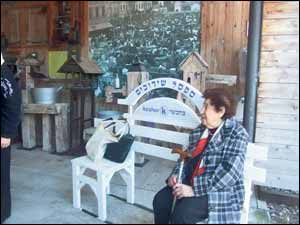 | |||||
| Journey into past at Polish shtetl in Israel | |||||
A SMALL but impressive Polish shtetl can be found in Kfar Hasidim, a religious agricultural community sitting in the shadows of the Carmel Mountains.
Kfar Hasidim, where the Jezreel Valley and Zebulun meet on the eastern outskirts of Haifa, was originally settled in 1924 by two groups of chassidim from Poland, together with their leaders, the rabbis of Kozienice and Yablonov. The moshav eventually became a member of the Hapoel HaMizrachi movement. These days, homes of Israeli Druze are visible on the mountain peaks opposite the community and nearby Arab villages spread across a range of hills.
The recreation of a small Jewish town or village in eastern Europe is the work of Israeli-born Gad Yakobi, a Yiddish language and culture-loving farmer, historian and klezmer aficionado. For an extended period, Gad worked as an Israeli emissary in agricultural development in the former Soviet Union, during which time he also travelled extensively throughout eastern Europe. During this period he collected artifacts, and shipped them back home to his South African-born wife (whom he met in the 1960s when she was working on a religious kibbutz) and their children at Kfar Hasidim.
A visit to Yankele’s Shtetl immediately exposes one to a blast from the past of sounds, smells and lifestyle of the mostly market town Jewish communities of the 19th and early 20th centuries so brutally eradicated by pogroms and the Holocaust. Gad Yakobi could well be an extra in a modern day theatre production of Jewish joy, suffering and long, agonising schlepps from a shtetl to a better life far, far away. However, for Gad, preserving the richness of Jewish life in the mostly impoverished shtetls of eastern Europe is not just entertainment, but steeped in a burning wish to have fellow Ashkenazi Jews maintain connections to their roots.
There are also shelves packed to the last inch with cooking utensils and other everyday kitchen and household items of those times. Surrounding the main recreated shtetl building are scores of waist high models of narrow streets, wooden buildings, a flour mill, small shops and synagogue, and more everyday artefacts from those days.
A plain white bench under a photograph of a busy shtetl market is labelled ‘The Shidduch Bench’, a smaller label underneath declaring it is ‘kosher’. Seated comfortably in the shtetl cultural centre, storyteller extraordinaire Gad begins with the story of his own immigrant family, who hailed from Germany, and that of the founders of Kfar Hasidim. He has the audience of elderly Israelis from a nearby kibbutz tapping their feet, clapping their hands as they sing along with him familiar songs from their childhood. Before they know it, Gad opens their memory boxes — kickstarting long dormant lullaby tunes, Yiddish sayings and one-liners, sharing and comparing stories of their own grandparents and parents who are long gone but their rich historical and cultural inheritance kept alive.
If you have a story or an issue you want us to cover, let us know - in complete confidence - by contacting newsdesk@jewishtelegraph.com, 0161-741 2631 or via Facebook / Twitter
|




